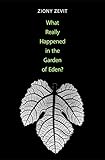What really happened in the Garden of Eden? / Ziony Zevit.
Material type: TextPublisher: New Haven : Yale University Press, [2013]Description: 1 online resource (xxvii, 368 pages) : illustrations, mapsContent type:
TextPublisher: New Haven : Yale University Press, [2013]Description: 1 online resource (xxvii, 368 pages) : illustrations, mapsContent type: - 9780300195330
- 0300195338
- Bible. Genesis, II-III -- Criticism, interpretation, etc
- Genesis. Paradieserzählung
- Bible. A.T. Genèse -- Critique et interprétation
- Eden
- Fall of man
- Éden
- Chute de l'homme
- paradise (doctrinal concept)
- RELIGION -- Biblical Studies -- Old Testament
- RELIGION -- Biblical Criticism & Interpretation -- Old Testament
- Eden
- Fall of man
- Éden
- Péché originel
- 222/.1106 23
- BS1237 .Z48 2013eb
- online - EBSCO
| Item type | Current library | Call number | URL | Status | Notes | Barcode | |
|---|---|---|---|---|---|---|---|
 eBook
eBook
|
Biblioteca "Angelicum" Pont. Univ. S.Tommaso d'Aquino Nuvola online | online - EBSCO (Browse shelf(Opens below)) | Online access | Not for loan (Accesso limitato) | Accesso per gli utenti autorizzati / Access for authorized users | (ebsco)660061 |
Browsing Biblioteca "Angelicum" Pont. Univ. S.Tommaso d'Aquino shelves, Shelving location: Nuvola online Close shelf browser (Hides shelf browser)

|

|

|

|

|

|

|
||
| online - EBSCO Revelation : a new translation with introduction and commentary / | online - EBSCO David : the divided heart / | online - EBSCO Culture and the death of God / | online - EBSCO What really happened in the Garden of Eden? / | online - EBSCO The formation of the Jewish canon / | online - EBSCO Common Faith : Second Edition. | online - EBSCO The Huguenots / |
Includes bibliographical references (pages 335-355) and index.
Online resource; title from e-book title screen (JSTOR platform, viewed February 22, 2016).
Introduction: The Fall is with us always -- Part 1. Now and then. The Fall in interpretation ; The Fall in the Hebrew Bible ; Who wrote the garden story and when? ; What is a reader-response approach to interpreting the garden story? ; Reading, presenting, and evaluating the garden story -- Part 2. Before then. A down-to-earth story (Gen 2:4-7) ; Why Eden? Why a garden? Where were the trees? (Gen 2:5, 8-10) ; Where in the world was Eden? (Gen 2:10-14) ; The gardener and his tasks (Gen 2:15) ; The second commandment (Gen 2:16-17) ; The first social welfare program (Gen 2:18-20) ; The first lady (Gen 2:21-23) ; Why "therefore"? (Gen 2:24) ; How bare is naked? (Gen 2:25) ; Clever conversation and conspicuous consumption (Gen 3:1-6) ; Dressing up for a dressing down (Gen 3:7-11) ; Interrogation and negotiation (Gen 3:11-13) ; Procreation in the garden (Gen 3:14-19; 4:1-2) ; Not a leg to stand on: the serpent's sentence and the Israelite culture of "curse" (Gen 3:14-15) ; No bundle of joy: Hawwa's sentence and Israelite predilections in legal reasoning (Gen 3:16) ; Toil and trouble: Adam's sentence and the rights of laborers (Gen 3:17-19) ; Out of the garden (Gen 3:20-24) -- Part 3. Then and now. The essential plot of the garden story ; A literal translation of a literary text ; Allusions to the garden story in the Hebrew Bible ; Contra the common interpretation ; Beyond the Tower of Babel -- Appendix: Transliterating Hebrew for tourists in the garden.
The Garden of Eden story, one of the most famous narratives in Western history, is typically read as an ancient account of original sin and humanity's fall from divine grace. In this highly innovative study, Ziony Zevit argues that this is not how ancient Israelites understood the early biblical text. Drawing on such diverse disciplines as biblical studies, geography, archaeology, mythology, anthropology, biology, poetics, law, linguistics, and literary theory, he clarifies the worldview of the ancient Israelite readers during the First Temple period and elucidates what the story likely meant in its original context. Most provocatively, he contends that our ideas about original sin are based upon misconceptions originating in the Second Temple period under the influence of Hellenism. He shows how, for Ancient Israelites, the story was really about how humans achieved ethical discernment. He argues further that Adam was not made from dust and that Eve was not made from Adam's rib. His study unsettles much of what has been taken for granted about the story for more than two millennia and has far-reaching implications for both literary and theological interpreters.
English.


